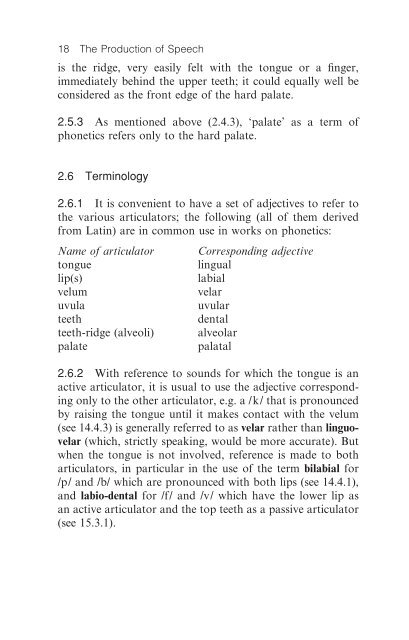An Introduction to French Pronunciation
An Introduction to French Pronunciation
An Introduction to French Pronunciation
You also want an ePaper? Increase the reach of your titles
YUMPU automatically turns print PDFs into web optimized ePapers that Google loves.
18 The Production of Speech<br />
is the ridge, very easily felt with the <strong>to</strong>ngue or a finger,<br />
immediately behind the upper teeth; it could equally well be<br />
considered as the front edge of the hard palate.<br />
2.5.3 As mentioned above (2.4.3), ‘palate’ as a term of<br />
phonetics refers only <strong>to</strong> the hard palate.<br />
2.6 Terminology<br />
2.6.1 It is convenient <strong>to</strong> have a set of adjectives <strong>to</strong> refer <strong>to</strong><br />
the various articula<strong>to</strong>rs; the following (all of them derived<br />
from Latin) are in common use in works on phonetics:<br />
Name of articula<strong>to</strong>r Corresponding adjective<br />
<strong>to</strong>ngue lingual<br />
lip(s) labial<br />
velum velar<br />
uvula uvular<br />
teeth dental<br />
teeth-ridge (alveoli) alveolar<br />
palate palatal<br />
2.6.2 With reference <strong>to</strong> sounds for which the <strong>to</strong>ngue is an<br />
active articula<strong>to</strong>r, it is usual <strong>to</strong> use the adjective corresponding<br />
only <strong>to</strong> the other articula<strong>to</strong>r, e.g. a /k/ that is pronounced<br />
by raising the <strong>to</strong>ngue until it makes contact with the velum<br />
(see 14.4.3) is generally referred <strong>to</strong> as velar rather than linguovelar<br />
(which, strictly speaking, would be more accurate). But<br />
when the <strong>to</strong>ngue is not involved, reference is made <strong>to</strong> both<br />
articula<strong>to</strong>rs, in particular in the use of the term bilabial for<br />
/p/ and /b/ which are pronounced with both lips (see 14.4.1),<br />
and labio-dental for /f/ and /v/ which have the lower lip as<br />
an active articula<strong>to</strong>r and the <strong>to</strong>p teeth as a passive articula<strong>to</strong>r<br />
(see 15.3.1).












